|
|
|
|
 |
| CZ Engagement Rings: Are Diamonds A Girl's Best Friend? |
| 09/12/2012 |
The moment arrives. Down on one knee, a nervous guy asks his lovely gal to be his bride. He flashes the ring, and the gal discovers it’s not a diamond but a cubic zirconia. Is she disappointed? Is she irate? Does she say “no?” She certainly does not! CZ engagement rings are becoming more and more popular. Many individuals prefer the man-made beauties over the more expensive diamond and not just because of the difference in cost. Here are just a few reasons cubic zirconia (CZ) are gaining popularity: 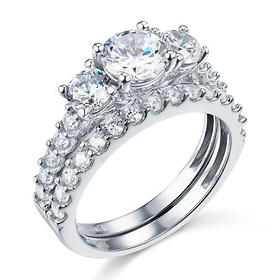
- Cubic zirconia can possess quality similar to diamonds.
- They are not involved with the conflict-diamond-plight that plagues many African nations.
- Cubic zirconia is becoming more popular among celebrities and dignitaries.
- They are considerably less expensive than diamond jewelry.
Similarities among CZ engagement rings and diamond rings
One major appeal to the cubic zirconia is that it possesses qualities similar to diamonds. Many individuals are not trained to know the difference with the naked eye. Just as real diamonds are graded by the four “C’s,” cubic zirconia can possess the same qualities. The following four components are examined when determining the value of a diamond:
- cut
- clarity
- color
- carat weight
Man-made cubic zirconia can vary in these four areas as well. Not all possess the same clarity or color, they come in a variety of sizes, and they can be cut and shaped in different ways. A cubic zirconia that is made well will look very similar to a diamond.
Cubic zirconia and conflict diamonds
Two-thirds of the world’s diamonds originate from western Africa, a place that is known for diamonds that are mined in war zones. These diamonds can be sold to fund terrorist activities and can cause the shedding of innocent blood. Because cubic zirconia is man-made, it does not contribute negatively to conflict diamond activity. In fact, it can help to prevent it. Brides-to-be can rest assured that the purchase of their CZ rings wouldn’t have funded terrorist activity nor would it have been used to cause undue bloodshed and violence.
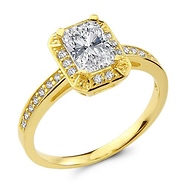 A popular choice among celebrities and dignitaries A popular choice among celebrities and dignitaries
It is not surprise that the new princess, Kate Middleton, is watched like a hawk for her fashion sense. At her recent appearance at the Queen’s Diamond Jubilee, Princess Kate wore cubic zirconia earrings. It was an event whose namesake might have encouraged the display of diamonds, but Kate chose cubic zirconia instead. It is a popular choice, and CZ engagement rings are also becoming more and more popular.
Less expensive
Another great benefit to a CZ ring is that it can be a lot less expensive than a diamond ring. When considering the similarities between diamond and cubic zirconia engagement rings, it might also be a good idea to consider the cost. Both can be set in precious metal, both can be striking to look at, both are popular. But only one is conflict free and cost friendly.
Have any comments or questions? Please share in our Facebook page! |
|
|
Posted by Connie at 1:19 PM - Link to this entry Share this entry
|
|
 |
|
 |
| Understanding the Four C's - Diamond Buying Guide |
| 11/11/2010 |
Treasured for centuries, diamonds are still the most popular precious stone for all types of jewelry, such as diamond engagement rings and diamond wedding ring sets. Diamonds come in all different sizes, shapes, prices, and quality. Knowing what to look for when shopping for diamonds can help ensure that you're getting what you're paying for.
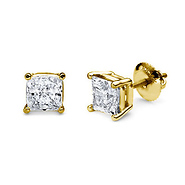
There are four characteristics that are used to determine a diamonds appearance and its overall durability. Those four factors include color, clarity, cut and carat weight and are known as the "Four C's". While there aren't any set rules for a perfect diamond, these four characteristics can help you find the best diamond for your money.
Diamond Color
The highest quality diamond color is white, or colorless, and very expensive. All white diamonds have slight tints of yellow or color, so the whiter the more expensive. Diamond color is graded from F - Z (colorless to light yellow). Most diamonds tend to fall in the G - J range.
However, diamonds can also naturally come in intense yellow, pink, red, brown, blue, and other colors, which are rarer and ultimately more expensive than white diamonds. Colored diamonds are becoming increasingly popular the past couple of years. Although naturally colored diamonds do exist, some diamonds are color treated or enhanced through a process using irradiation or heat.
Diamond Clarity
Every natural diamond has internal flaws or inclusions. The number, size, and location of inclusions determine the clarity. It also includes any external imperfections on the stone. Diamond clarity is graded as the following:
- FL - flawless
- IF - internally flawless
- VVS1 - Very very slightly included
- VVS2- Very very slightly included
- VS1 - Very slightly included
- VS2 - Very slightly included
- SI1 - Slightly Included
- SI2 - Slightly Included
- I1 - Included
- I2, I3
While a diamond's clarity is very important, a lower clarity grade diamond isn't necessarily a poor quality diamond. Most natural flaws are invisible to the naked eye. The main inclusions to worry about are those that directly affect the diamonds durability, which can lead to cracking or chipping.
Diamond Cut
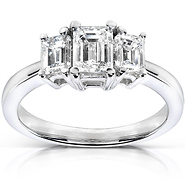
The diamond cut generally refers to the style of how the gemstone was cut and includes the following characteristics: depth, width, symmetry, proportions, and polish. Remember, diamonds found in the earth look more like rocks you see on the ground. Diamond cutters shape them into jewelry and in a way that reflects the most light and interesting designs. The cut is probably the most important of the four C's. A perfect diamond can become a low grade stone if cut poorly. For instance, the stone is too shallow, got chipped, poor design, etc. The precision with which a diamond is cut is a direct reflection on the beauty of the stone. The arrangement of the facets determine how light is reflected and creates the brilliance which makes diamonds so fiery. While there are various shapes of diamonds, the cut doesn't actually refer to the shape, such as round, rectangular.
Diamonds come in a variety of cuts with new ones coming up over time from master diamond cutters. Some of them include briliiant, princess, asscher, baguette, and emerald.
Diamond Carat
Diamond Carat (abbreviated as ct) refers to its size. Generally, as the carat weight increases, the price increases as well, especially if the other diamond characteristics are valuable. The price becomes exponentially higher for 1 ct diamonds and higher. However, diamonds of smaller sizes can be more precious than a larger diamond depending on the four C's but the differences has to be pretty significant.
Shopping for a diamond wedding band, stud earrings, and other jewelry can be less daunting when you know what to look for in quality diamonds. Remember the four C's of diamonds - Color, Clarity, Cut, and Carat.
GoldenMine has an extensive collection of diamond jewelry. Visit GoldenMine to find that exquisite jewelry piece here today!
**********
Refer to this Buying Guide to get more information on the four C's of diamonds. |
|
|
Posted by Connie at 4:00 AM - Link to this entry Share this entry
|
|
 |
|
 |
| Diamond bracelets glistened at the Oscars: One just isn't enough |
| 03/08/2010 |
Despite the drizzle during the Academy Awards last Sunday, March 7, 2010, the celebrities still dazzled the viewers as they strutted down the Red Carpet with their couture jewelry and designer gowns. The red carpet coverage is one of my favorite parts about watching the Oscars, and I still enjoyed watching it this time around. I especially paid particular attention to the jewelry that the women wore to get ideas on how to update my own jewelry style. Perhaps it'll inspire you as you accessorize your next outfit or when you want to buy new jewelry.
While most celebrities wore the usual white diamond jewelry and platinum, one trend stood out - wearing multiple diamond bracelets. A number of female celebrities wore a mixture of different diamond bracelets, at least two or more bracelets, on one arm. For example:
- Jennifer Lopez, international pop singer and actress, fashioned three distinct but complimentary multi-gem bracelets in yellow and white diamonds, onyx, and emeralds that shined next to her black dress.
- Sarah Jessica Parker, Sex and the City star, wore an assortment (about seven or eight) of white diamond bangle and link fancy bracelets,
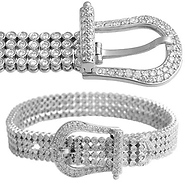 varying in widths and styles. varying in widths and styles.
- Rosario Dawson, 25th Hour and Sin City actress, showed off two white diamond bracelets against the slit of her fuchsia dress.
- Mariska Hargitay, from Law & Order: Special Victims Unit, wore a stunning collection of two different white diamond link bracelets with a white diamond and dark blue gemstone bracelet set in the middle, matching her dark, flowing dress.
- Kat Denning, Nick and Norah's Infinite Playlist star, glistened with three gold ball bracelets accented with diamonds. Unlike most of the other woman mentioned above, the gold took center stage in this jewelry instead of the gemstones.
 It's really simple to achieve these celebrity looks at home! Raid your own bracelet collection and start matching them up - two, three, or eight at time - go crazy and experiment. You can look just as fashionable as the women walking down the Red Carpet. It's really simple to achieve these celebrity looks at home! Raid your own bracelet collection and start matching them up - two, three, or eight at time - go crazy and experiment. You can look just as fashionable as the women walking down the Red Carpet.
|
|
|
Posted by Shenna at 3:28 PM - Link to this entry Share this entry
|
|
 |
|
 |
| Diamonds & Cubic Zirconia Jewelry |
| 08/07/2009 |
I was fascinated while watching the Oscars recently by the diamond jewelry, such as the 40-carat diamond necklace from The House of Winston worn by Gwyneth Paltrow. Many of the glitterati were festooned with pieces on loan from various jewelers hoping to curry favor with the beautiful people and their fans, enormously expensive pieces that set the cameras on fire every time they caught the light.
I've never had the nerve to borrow anyone's diamonds, but then again, the most formal event I attend these days is a basketball game. Even there, though, many in the stands (and some on the floor) glitter with diamond simulants.
Glitter, from diamonds and their simulants, I think, is a 20th century contribution to common man. In fact, the notion that the average person could even wear a diamond is recent. For thousands of years, the stone's primary role was to provide a currency for commerce between rulers, a way of paying favor to military victors, and a method of bartering for fertile daughters. In the 13th century, for example, France's King Louis IX restricted diamond jewelry to the aristocracy. The stone was worn only by men until 1477, when the Archduke Maximilian of Austria gave a diamond ring to Mary of Burgandy. 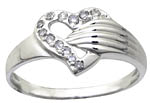
The word diamond derives from the Greek adamao, meaning, "I subdue". Since the diamond is the world's hardest known substance, it truly does subdue all others. Personally, I favor the Sanskrit name for diamond -- 'varja', meaning thunderbolt. I like the idea of wearing a thunderbolt on my finger.
In the last hundred years, though, many simulants have been developed that allow any of us, regardless of income, to shine like a movie star.
The first commonly used diamond substitute was glass. Jewelers found that adding lead oxide to the glass made it shine more brightly. Adding foil to the back of these glass gems gave us the popular rhinestone. They didn't match diamond's fire or durability, but were cheap enough to use in profusion.
Then, late in the 19th century, the French learned to grow clear spinel and sapphire crystals. These could be faceted like diamonds, wore better than glass, and soon found their place as substitutes in better-quality jewelry. Neither, however, had nearly the light-refracting properties of diamond.
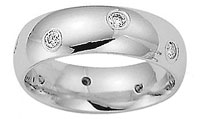 In the 20th century, more sophisticated substitutes were discovered. The most widely known is that star of cable television, the cubic zirconia. CZs are very inexpensive and wonderfully bright stones, used in profusion in faux- bling (the word gaudy no longer has any meaning). However, CZs are not very durable, especially in rings, and the least amount of dirt dulls them. In the 20th century, more sophisticated substitutes were discovered. The most widely known is that star of cable television, the cubic zirconia. CZs are very inexpensive and wonderfully bright stones, used in profusion in faux- bling (the word gaudy no longer has any meaning). However, CZs are not very durable, especially in rings, and the least amount of dirt dulls them.
In the past ten years, an excellent diamond stimulant,the Moissanite, has come into common use. The gem, silicon carbide, was first discovered in the remnants of the meteor that formed Diablo Canyon in California. Over 100 years passed before man learned to grow the crystal commercially.
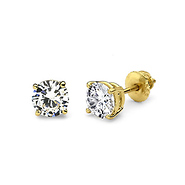 Moissanite has a number of advantages over other diamond simulants. It is very hard (92% that of diamond), clear, colorless, and approximates diamond's sparkle. It is also a tenth the price. Moissanite has a number of advantages over other diamond simulants. It is very hard (92% that of diamond), clear, colorless, and approximates diamond's sparkle. It is also a tenth the price.
So today there is glitter available at any price point, allowing us to indulge our urge to sparkle. That's a good thing.
In fact, my wife recently asked me, why, if she could get almost as much sparkle from diamond substitutes as diamonds, we should buy a diamond? As I thought about her question, a scenario kept replaying in my head. I saw a young girl opening her mother's jewelry box, picking up her mother's engagement ring, or her grandmother's. The thing about diamonds is, as the hardest substance on earth, they are as near eternal as anything we can ever hold. In the movie playing in my head, I couldn't envision the girl putting her mother's ring on her finger and saying to herself, 'this was my Mom's Moissanite."
A diamond is many things; currency, love, glamour, bling. But other stones can stand in for a diamond in those roles. To hold precious memories, though, a diamond is truly matchless.
So shine on, any way you wish. You deserve to sparkle. |
|
|
Posted by Tom B at 5:37 PM - Link to this entry Share this entry
|
|
 |
|
 |
| Cut of Diamonds |
| 12/31/2007 |
Of the classic four C's of diamond grading (cut, clarity, color and carat weight) the hardest for buyers to get their minds around is cut. The weight of a diamond is a simple matter for a scale. Color becomes apparent when the gem in question is set alongside a grading set that shows the range of hues commonly found in diamonds; lighter than that one, darker than this one. Under a microscope, the tiny inclusions that interfere with a stone's clarity stand out like a blond hair on the suit coat of a man with a red-headed wife.
Cut is much more complex. A modern round brilliant diamond has 58 separate surfaces or facets, each of which has an ideal proportion and orientation to the others. Because of this complexity, there is not a clear-cut rating of cut to match that of color and clarity.
However, the ideal of a well-cut diamond is simple- One cut to guide light through it that produces the most brilliance and fire possible.
 Think of this analogy. Suppose you lived in the desert and wanted to heat a tank of water to do laundry. If you had a bunch of mirrors, you could set them around the tank, arranging them so that sunlight was reflected directly on the tank. Enough beams of light and you could have that water boiling merrily away. Think of this analogy. Suppose you lived in the desert and wanted to heat a tank of water to do laundry. If you had a bunch of mirrors, you could set them around the tank, arranging them so that sunlight was reflected directly on the tank. Enough beams of light and you could have that water boiling merrily away.
If, however, some of the mirrors slipped, sent light into a sandstone rock face or into the sand underfoot, the water may remain tepid. There are a lot of 'tepid' diamonds on the market, flat and lifeless.
To continue with the mirror analogy, the ideal cut for a brilliant diamond arranges those mirrors perfectly to bounce light from facet to facet and produce flashes of light as the stone is rotated.
A round brilliant that is cut to ill proportions might show a fish-eye-like ring inside, or a dark spot in the center of the stone, or other detracting flaws.
You might ask, if a diamond cut to modern proportions is so appealing, why aren't all diamonds cut this way? The answer is cost. When the cutter sizes up a rough diamond, he is looking to get as much value from it as possible. Often, the crystal will have inclusions (carbon spots, crystal feathers, and the like,) that would end up in the middle of a standard-cut brilliant, ruining the fire of the stone. To cut around these to reach the clear areas from which a brilliant cut can be made could require wasting a large portion of the stone. However, by fudging on the proportions, by, for example, cutting the gems a little wider and a little shorter, two or three so-so stones can be produced. As long as customers are willing to pay for such stones, and aren't willing to pay the difference to buy a diamond with ideal proportions, this method maximizes producer profit.
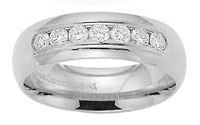
There are dozens of other 'fancy' cuts of diamonds, such as the rectangular emerald, the marquise (like a cat's eye), pear, and oval, all of which also have ideal proportions for maximum fire. However, larger stones in these styles are less popular and therefore not as prevalent in your local jewelry store. So what can you do to assure the diamond you're considering is well cut? Ask your jeweler to show you a well-cut stone. Note how the facets are symmetrical, the girdle (the outside edge) is neither fat nor knife-thin and uniform, how the proportion between the upper part and lower part of the diamond is roughly one to three. Most importantly, though, look at it face on. Does it fire?
For my money, I'd rather buy a smaller stone with excellent conformation than a larger one with goofy proportions. Regardless of what some in our bling bling world would have you believe, size and beauty are not the same thing. And proportion is the key. |
|
|
Posted by Tom B at 11:34 AM - Link to this entry Share this entry
|
|
 |
|
 |
| Pink, the Color of Love |
| 11/12/2007 |
What do you associate with the color pink? Femininity? Tenderness? The fist of a baby? A mohair sweater? If you're like me, like most Americans, pink is the color of love. And since love and jewelry are so inexorably intertwined, we're fortunate to have so many pink gemstones from which to choose.
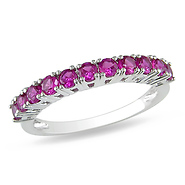 The queen of the pinks is the diamond, unmatched for fire and durability. However, the color of most colored diamonds, including pink, yellow, brown, orange, blue, and green, aren't pure. Only the rarest are free of hints of gray or brown that muddles the hue. Diamonds with any amount of red are the rarest of all diamonds, so a fine pink is among the priciest stones in the world. If you find a pink diamond at a reasonable price, be very wary. It could have been be treated, or even coated to produce the color. The queen of the pinks is the diamond, unmatched for fire and durability. However, the color of most colored diamonds, including pink, yellow, brown, orange, blue, and green, aren't pure. Only the rarest are free of hints of gray or brown that muddles the hue. Diamonds with any amount of red are the rarest of all diamonds, so a fine pink is among the priciest stones in the world. If you find a pink diamond at a reasonable price, be very wary. It could have been be treated, or even coated to produce the color.
Happily, there other great gems with more satisfying color at a more reasonable price. One of the prettiest is the little-known kunzite, a pink gem with a hint of violet. Kinzite wasn't discovered until 1912, but quickly became popular when Tiffany & Co. began using it in art deco pieces. With kunzite, the depth of color changes depending on the viewing angle. In a well-cut stone, the deepest saturation appears with the stone face-up. The jewel is, however, somewhat fragile, and its nickname, "The Evening Stone", refers to its propensity to fade if exposed to strong sunlight.
Another popular choice is the pink sapphire. While we usually associate sapphires with the color blue, the gem takes on a rainbow of colors, including the red that we call rubies. While natural pinks are uncommon, man-made pink sapphires with deeply saturated color are readily available. This is a great choice if durability is an issue for you, as sapphires are second only to diamonds in hardness.
 Morganite is a member of the beryl family, which also includes emeralds and aquamarines. The pink stone was named after tycoon J.P. Morgan. Perhaps because of this, it never caught on with the American public, although the price, durability, and beauty of the stone suggests it deserves more recognition. Morganite is now being marketed under the name 'Pink Emerald'. Time will tell if this increases its appeal. Morganite is a member of the beryl family, which also includes emeralds and aquamarines. The pink stone was named after tycoon J.P. Morgan. Perhaps because of this, it never caught on with the American public, although the price, durability, and beauty of the stone suggests it deserves more recognition. Morganite is now being marketed under the name 'Pink Emerald'. Time will tell if this increases its appeal.
'The great imposter' is the nickname give to spinel because it comes in a variety of lovely colors that mimic more expensive gems. Natural pink spinel is rare, though, and priced accordingly. However, man-made spinel is readily available, inexpensive, and durable. If you're looking for great color without a great price tag, a pink spinel could suit the bill nicely.
My favorite pink stone, though, is the tourmaline. This gem comes in a full spectrum of deeply saturated colors, including a lovely pink. Pieces of excellent clarity are reasonably priced, and the gem is hard enough to stand up to daily wear. My wife sports a beautiful 5-carat oval that I mounted for her 10 years ago, and it still looks like new. If you want a large, durable pink, tourmaline is your best bet.
There are still more choices for pink stones; pink topaz, rose quartz and pink cubic zirconium, however, are all on the fragile side for rings.
The color of love makes a great choice for fine jewelry, and the variety of stones available puts a fine pink in almost anyone's price range. So think pink! |
|
|
Posted by Tom B at 12:52 PM - Link to this entry Share this entry
|
|
 |
|
 |
| Explaining the Mohs Scale |
| 10/29/2007 |
Ask the average jewelry buyer who Friedrich Mohs is, and they will quickly rack their brain trying to remember the name of their salesperson. Not to worry, you have not made a social faux pas. Friedrich Mohs was a German mineralogist who devised a method of comparing the scratch resistance of minerals back in the 1800's. Why is that important you, the average buyer? Well, gemstones are minerals and therefore ranked on this scale according to durability. Keeping in mind that when you are buying a gift for someone (or even a little something for yourself), you want to buy something that not only looks nice, but something that will last a long time. A basic understanding of the hardness of minerals will save you headaches in the long run.
First of all, Friedrich Mohs devised this scale based upon a very basic test. He took ten easily found minerals and arranged them in 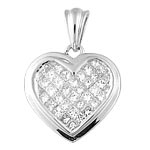 order of what will and what won't scratch each other. It is as simple as that. If a mineral can be scratched, it is softer; if it cannot, it's harder. And so the rank of 1-10 was developed; ten listed as the hardest mineral, the diamond, and one listed the softest, talc. Does that mean that a diamond is ten times more durable than talc? Surprisingly, no. The scale is less of a scale and more of a table. Meaning, the durability difference between a ranking of a 8 compared to a 9 is different than a ranking of a 9 compared to a 10. Simply put, the diamond (a 10) is not harder than a ruby (a 9) by a difference of one; a diamond is many times harder than a ruby, there is simply no mineral that ranks in between them. order of what will and what won't scratch each other. It is as simple as that. If a mineral can be scratched, it is softer; if it cannot, it's harder. And so the rank of 1-10 was developed; ten listed as the hardest mineral, the diamond, and one listed the softest, talc. Does that mean that a diamond is ten times more durable than talc? Surprisingly, no. The scale is less of a scale and more of a table. Meaning, the durability difference between a ranking of a 8 compared to a 9 is different than a ranking of a 9 compared to a 10. Simply put, the diamond (a 10) is not harder than a ruby (a 9) by a difference of one; a diamond is many times harder than a ruby, there is simply no mineral that ranks in between them.
Where do your favorite gems rank? If you have ever wondered what the big deal was surrounding the importance of diamonds, it will be no surprise to you to find out that diamonds rank at the top of the hardness scale. A great number of factors figure in to why diamonds are the ultimate symbol of love and beauty, one of which is the symbolism of the hardest naturally occurring substance in the world interlaced with the idea of one's devotion possessing the same unyielding properties.

A number nine on Mohs scale is corundum, more commonly known as sapphire and ruby. Many are surprised to find out that these two different gems have the same mineral properties. Sapphires are not just blue; in fact, corundum is found in a wide variety of colors, most of which are referred to as sapphire, while only red corundum is called ruby.
Another gem available in a wide variety of colors is topaz, number 8 on Mohs scale. Commonly available in yellow-brown and blue, topaz can also be green, pink, orange, and even colorless. In fact, there is no such thing as naturally occurring blue topaz. What you see as blue topaz in the stores is actually topaz which has been heat treated to turn them blue.
Another common precious gem, the emerald, has a unique place on Mohs scale at a 7.5 to 8 hardness level. As you look around a jewelry store, you may begin to wonder why an emerald is more expensive than a topaz, a gem that is more durable. The answer is simple; the highest naturally occurring emerald will be more expensive than a diamond because of its rarity, which is why more affordable synthetic emeralds are being developed. Emeralds are considered high on the hardness scale because of their resistance to scratching; however, natural emeralds are in fact brittle stones and should be treated more gingerly.
There are innumerable amounts of quartz varieties which fall at a level 7 on the scale. Common gems included in this group are amethyst and citrine. Opal is also a variety of quartz, but it is a hydrated, solidified quartz gel, which is why it is not faceted for jewelry purposes, but appears domed in shape.
When buying a gem, consider the Mohs scale as a great reference tool. Does it mean that you should shy away from a gem based upon it's placement on the scale? Certainly not. But understanding the scale will help you make an educated decision about what to buy based upon how you wear and how you care for your jewelry. |
|
|
Posted by Kim G at 12:28 PM - Link to this entry Share this entry
|
|
 |
|
 |
| Why A Diamond's Cut Is Crucial To Its Quality |
| 10/02/2007 |
Half Of A Diamond's Worth Is Based On Its Cut
Although all of the '4 C's -- carats, clarity, color and cut -- are important when choosing a quality diamond, cut is considered the most crucial characteristic.
Without a good cut, a diamond will not be as brilliant and sparkle as much as it could. This is why half the worth of a diamond is based on its cut.
The less symmetrically proportioned a diamond is, the less fire and brilliance it will have no matter what shape it is cut into. The jeweler chooses the shape such as round, marquise, heart, pear, emerald, princess, radiant or oval based on how well the light will be refracted in the cut diamond. Placement of the facets is very important to allow for the brightest shine. Most diamonds are cut to have 58 facets.
These 7 Main Considerations Of A Diamond's Cut Determine Its Brilliance:
- Table Percent -- the measurement of the flat topped, biggest facet of the diamond
- Crown Angle -- the angled upper part of a diamond that connects the table and the girdle
- Girdle -- the part of the diamond that attaches to the setting and forms the diamond's perimeter, connects the crown and the pavillion
- Pavillion Percent -- the angled lower part of a diamond that connects the girdle and the cutlet
- Cutlet Size -- the faceted tip of the diamond, has to be the correct size to avoid chipping
- Symmetry -- refers to how well the facets are created and connected geometrically, if the facets are not well-aligned, the light can not refract well and the, diamond will not be as brilliant as it could be
- Polish -- refers to how smooth the diamond's facets are on the surface, if the facets are not smooth, the stone may look dark or blurry rather than clear and sparkly
The diamond must not be too shallowly cut or the light will not be refracted to its optimum level as some of the light will be directed to the base of the stone. If the diamond is cut too deeply, the light will also be redirected, but through the sides of the gem. A diamond that is cut too shallowly or deeply might even look dull. The cut that allows for the maximum light refraction and brilliance in a diamond is called a "fine cut" or "ideal cut."
The cut measurements of a diamond must be mathematically precise for maximum brilliance as the geometric proportions form a prism. The cuts are angled to refract the maximum amount of light to allow for the full color spectrum of the prism to be present. The color spectrum refraction adds to the "fire" of a diamond.
A Diamond's Cut Also Relates To Its Durability
The cutlet, or bottom tip of the diamond, has to be cut to the right size in order to deter chipping. The girdle is the part of the diamond that is attached to the setting and if the girdle is cut too thin, the diamond may chip or may not set properly. Diamonds should also be cut so that any feathery cracks are below the surface of the diamond. If these cracks are on the top of the diamond, the diamond will not be as durable as it could break more easily. |
|
|
Posted by Sheri L at 5:49 PM - Link to this entry Share this entry
|
|
 |
|
|
|
|